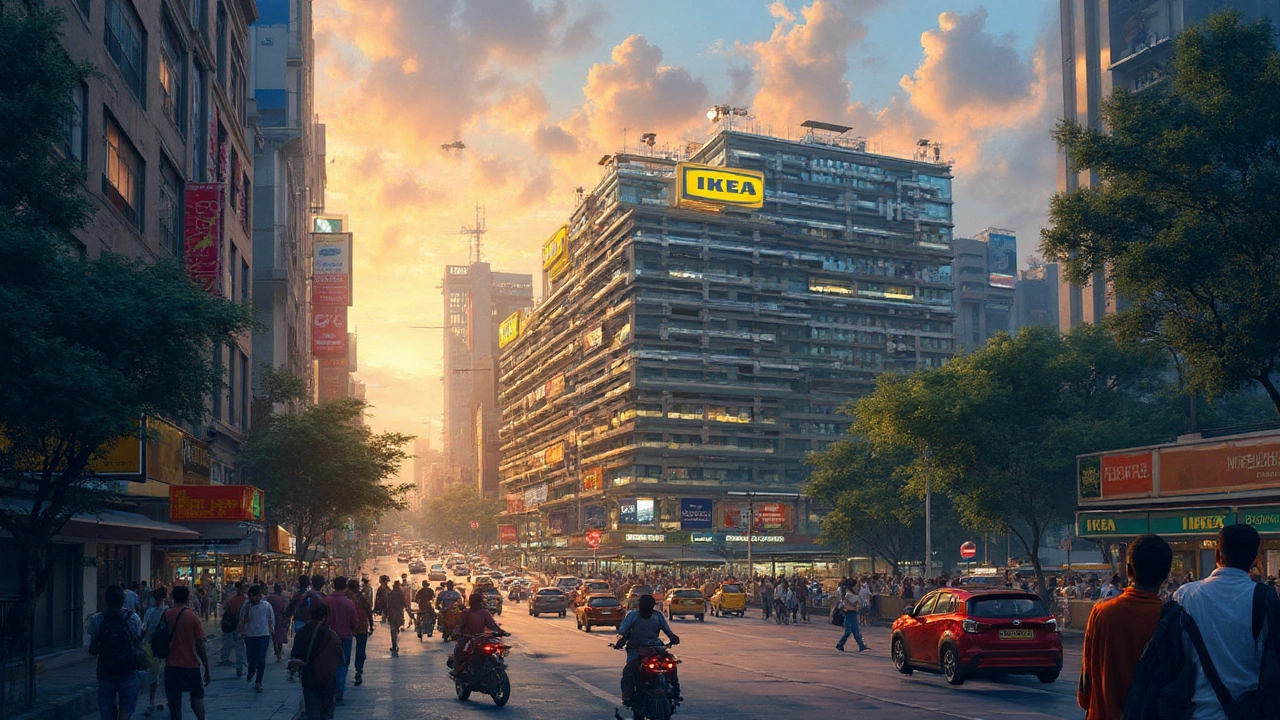Picture this: A country with over 1.4 billion people, a middle class that’s ballooned practically overnight, and a knack for turning everyday living spaces into personal sanctuaries. That’s India right now, and it's not hard to see why IKEA’s eyes are lit up like Diwali. The Swedish furniture giant has planted deep roots here, hungry to tap into cravings for affordable, good-looking furniture and a new kind of shopping experience. How’d a flat-pack behemoth from the north end up wooing Indian families, city dwellers, and students? The answer isn’t just cheap labor and big dreams—it’s way more interesting than that.
The Magnetic Pull: What Makes India Irresistible for IKEA?
India’s market isn’t just big; it’s hungry for change. With a young population (median age just under 29), aspirations are sky high. People want stylish, practical, and affordable furniture—not the kind that guzzles cash or is too delicate for family chaos. IKEA saw this appetite. Traditional Indian homes used to rely on heavy wooden furniture passed down the generations. But with more people moving to cities—think 400 million projected to live in urban India by 2030—the urge for flexible, easy-to-move stuff went through the roof.
Another lure? The rising middle class. KPMG’s 2024 Market Insights found that over 350 million Indians now fit the middle-class bracket, a number that could rival Europe’s entire population. These families earn more, travel, watch what’s trending globally, and demand brands that fit their new lifestyle. IKEA’s combo of functional design, affordable pricing, and do-it-yourself charm hits them right in the sweet spot.
Here’s a data point that makes furniture executives drool: By 2025, the organized Indian furniture market is projected to soar past $40 billion, up from about $24 billion in 2019 (Statista). Unlike European markets where IKEA has reached saturation, India’s formal furniture sector barely covers 15% of total sales. The lion’s share is still run by local carpenters, small shops, and mom-and-pop enterprises—ripe for someone to come in, organize, and scale up. It’s no accident IKEA has plans for 25 stores and e-commerce expansion to cover every metro area.
| Year | Indian Furniture Market Size (USD Billion) | IKEA Store Count in India |
|---|---|---|
| 2019 | 24 | 1 |
| 2022 | 32 | 5 |
| 2025 (proj.) | 41 | 11 (planned) |
Yes, there are challenges: wild commutes, tricky regulations, and sometimes skepticism toward do-it-yourself. But what keeps IKEA hooked is the opportunities outweighing the hassles—by miles. Rapid urbanization, unstoppable digital penetration, wider home ownership, and new tastes in every tier-two city—these forces make India a tantalizing growth playground for the world’s largest furniture retailer.
Cracking the Indian Consumer Code: IKEA’s Smart Moves
If you think IKEA just dumps global designs into India, think again. The company’s been sharp enough to pick up on local habits, quirks, and even pet peeves. First, there’s the food. Anyone who’s walked into an IKEA India store will remember the buzz at the restaurant. Instead of just Swedish meatballs, you get biryani, samosas, and masala chai. That alone pulls in crowds who may not even be shopping for furniture—turning stores into family destinations and hangout spots.
Then there’s product tweaking. Not many people outside India would think of using a sofa as a bed almost every night or expect their kitchen to serve as both a cooking and socializing hub. IKEA listens. Sofas are built a little sturdier, bed sizes are tweaked for Indian preferences, and modular kitchens get extra customization options. For storage, you’ll find stackable boxes and high-closet solutions—practical ways to handle smaller spaces in Indian apartments.
Price matters here, maybe more than anywhere else. A whopping 80% of urban households budget tightly, according to a recent survey by Nielsen. So, IKEA introduced wallet-friendly ranges and flexible payment plans. Some products sell for under ₹200 ($2.50), making them ultra-accessible even for college students or bachelors renting their first place.
IKEA is doubling down on e-commerce, too. While people love strolling through the maze-like stores, a Wisely Insights 2025 report found over 35% of Indian urban buyers now start their search online, especially for bulky items. IKEA’s web store covers Hyderabad, Mumbai, Bengaluru, and is rapidly rolling out to other cities so families can browse, order, and schedule delivery without traffic nightmares.
And then there’s the service. Unlike in Europe, where assembling flat-pack furniture is a weekend ritual, busy Indian families often want someone else to handle the hassle. IKEA responded by offering affordable assembly and installation services. This blend of global brand appeal and on-ground adaptability is IKEA’s secret sauce here.

Building Local: Sourcing, Manufacturing, and Supply Powerplays
IKEA’s India story isn’t just about selling furniture; it’s about making a lot of it right here. That’s key, because local production helps slash costs, dodge bloated import duties, and tick the right boxes on the "Make in India" campaign checklist. By 2024, IKEA sourced over 47% of its India store products locally, with plans to crank that up to 60% within a couple of years. The company is already working with more than 55 local suppliers, supporting over 70,000 jobs across India (IKEA Annual Report 2024).
Why does this matter? First, Indian wood, textiles, and skilled craftsmanship are recognized globally. Some of IKEA’s signature lines—think cotton-based bedding or rugs—now source directly from Indian mills or workshops. The company even partners with Indian women’s collectives for unique textiles and baskets, giving a steady livelihood boost to rural communities.
Take the city of Pune. IKEA invested in a massive 270,000 sq ft warehouse there to serve as a logistics and distribution hub. This not only powers fast delivery across western India but also cuts down on transport emissions and delays. The warehouse uses smart tech like automated stacking and digital inventory—proof that IKEA’s betting big on homegrown efficiency, not just imports.
It’s worth noting that government incentives, like the Production-Linked Incentive (PLI) scheme and relaxed FDI rules for single-brand retailers, have tipped things in IKEA’s favor. Setting up Indian plants or tie-ups has become smoother. The company’s supply-side presence acts like a magnet—other global brands are now eyeing Indian manufacturing, turning the country into a hub for exports across Asia and Africa, not just domestic sales.
Here’s a tip: if you’re a local business, getting certified as an IKEA supplier could open doors to international markets. IKEA runs regular supplier training, eco-certification programs, and improvement audits. If you can meet those standards, you’re not just serving the Indian market—you’re stepping onto a global stage.
The Road Ahead: Challenges, Innovations, and Consumer Craze
IKEA’s Indian adventure isn’t an easy ride. Traffic snarls make last-mile delivery a pain, while regulations can shift overnight and finding land for giant stores is tricky in crowded metros. Indians value haggling and touching their purchases; selling flat-packed furniture to millions who traditionally buy ready-made stuff is never a slam dunk. Plus, local competition from smart startups is fierce—companies like Pepperfry and Urban Ladder are throwing punches with digital-first models and customizable catalogues.
But IKEA is anything but complacent. They’re testing smaller formats—like city-center “IKEA Shops” that focus on fast-moving essentials and digital catalogs. They’re piloting mobile app-based interior consultations, “click and collect” services, and even AI chatbots to mimic the in-store experience online. With a sharp focus on sustainability, many store rooftops are covered in solar panels, and there’s a push for low-VOC finishes and recyclable packaging.
The craze is real: At launch, IKEA Hyderabad drew 40,000 visitors in one day. Stores host everything from kids’ crafts workshops to influencer tours. Social media buzz turns launches into must-see events. The IKEA effect—where buyers feel proud of what they assemble—works well in a country where doing more with less space is a national sport. For college hostels, first-jobbers, newlyweds, and nuclear families, IKEA’s flat-packs spark both function and pride.
If you’re running a related business, this is a wake-up call. There’s room for everyone in this rising tide: home delivery, eco-friendly packaging, digital home design, local boutique makers. Watch out for IKEA’s next moves—these could shape trends not just for the big chains, but the whole retail and IKEA India ecosystem.
The secret to IKEA’s Indian appeal? It’s not just the furniture—it’s their ability to shake up old habits, respect new ones, and blend world-class efficiency with real local taste. No wonder the Swedes are here for the long haul. If you think you’ve seen the end of their expansion, better take a seat—something Swedish, maybe, but probably made in India.

